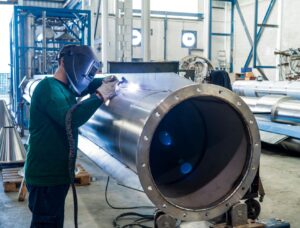Welding is the backbone of the manufacturing industry, enabling the production of everything from automobiles and appliances to heavy machinery and industrial equipment. Efficient and precise welding processes ensure high-quality, durable products while reducing production costs and minimizing waste.With advancements in welding automation and monitoring technology, tools like Mecaweld’s welding cameras enhance quality control, improve efficiency, and detect defects in real time. Explore how welding powers the manufacturing industry, from automotive to heavy equipment production.
Discover the latest welding innovations, robotic systems, and real-time monitoring solutions with Mecaweld to improve efficiency and quality. As manufacturers push for greater innovation, automated welding systems and real-time monitoring solutions are transforming the industry.
The Role of Welding in Manufacturing
Automotive Manufacturing: Precision and Speed
The automotive industry relies heavily on welding to assemble car bodies, frames, and components. Speed and accuracy are essential to maintain production efficiency and ensure vehicle safety.
Common Welding Methods in Automotive Manufacturing:
- Resistance Spot Welding (RSW): Used for joining sheet metal panels.
- MIG Welding (GMAW): Ensures strong, high-speed welds in vehicle frames.
- Laser Welding: Provides precision in delicate automotive components.
How Mecaweld Helps:
- Welding cameras monitor spot welds and seam welds in real-time, detecting inconsistencies before they lead to weld defects.
Heavy Equipment and Machinery: Durability and Strength
Manufacturing heavy equipment and industrial machinery requires high-strength welds capable of withstanding extreme stress.
Key Welding Applications:
- Welding structural frames for bulldozers, cranes, and tractors.
- Joining thick steel components for durability.
- Automated robotic welding for large-scale fabrication.
How Mecaweld Helps:
- Advanced weld monitoring systems ensure consistent weld penetration and strength in critical components
Consumer Goods and Appliances: High-Volume Production
Manufacturing household appliances, electronics, and metal furniture requires precision and efficiency.
Common Welding Techniques:
- Laser Welding: Ideal for thin materials like stainless steel.
- Resistance Welding: Used for electronic components and small parts.
- TIG Welding: Ensures clean, high-quality welds in stainless steel appliances.
How Mecaweld Helps:
- Real-time welding cameras enhance quality control in mass production.
Innovations in Welding Technology
Robotic Welding: Enhancing Speed and Accuracy
Robotic welding improves precision, speed, and efficiency, reducing human error and increasing productivity.
Benefits of Robotic Welding in Manufacturing:
- Consistent weld quality with minimal defects.
- Faster production cycles, reducing labor costs.
- Improved worker safety by minimizing exposure to heat and fumes.
How Mecaweld Helps: Integrates with robotic systems for automated weld inspection and monitoring.
Laser Welding: High-Precision Welding for Modern Manufacturing
Laser welding is a game-changer in automotive, aerospace, and electronics manufacturing.
Advantages of Laser Welding:
- Minimal heat distortion, making it ideal for delicate components.
- Deep penetration welds for high-strength applications.
- Fast processing speeds, increasing production output.
How Mecaweld Helps: Welding cameras provide real-time visualization to fine-tune laser welding parameters.
Real-Time Weld Monitoring for Quality Assurance
Why Real-Time Monitoring Matters:
- Detects defects immediately, preventing costly rework.
- Ensures compliance with manufacturing standards.
- Reduces material waste, improving efficiency.
Mecaweld’s welding cameras help manufacturers maintain precision and consistency in every weld.
Challenges in Welding for Manufacturing
Maintaining Consistency in Mass Production
Manufacturing high volumes of welded products demands uniform quality across all units.
Solution: Use automated weld monitoring to ensure every weld meets strict quality standards.
Minimizing Welding Defects
Common welding defects like porosity, cracks, and incomplete fusion can lead to product failures.
Solution: Real-time welding inspection cameras help detect defects instantly.
Worker Safety and Compliance
Welding fumes, heat, and high-voltage equipment pose risks to workers.
Solution: Implement robotic welding and remote monitoring to enhance safety.
The Future of Welding in Manufacturing
Industry 4.0 and Smart Welding Systems
The future of welding includes:
- AI-powered defect detection in real time.
- Cloud-based welding data analysis for improved quality control.
- Remote monitoring systems to oversee welding processes worldwide.
How Mecaweld Leads the Way: Advanced AI-integrated welding cameras provide real-time analytics for improved decision-making.
Sustainable Welding Practices
Manufacturers are focusing on eco-friendly welding techniques to reduce carbon emissions and material waste.
Sustainable Welding Innovations:
- Low-emission welding gases to reduce environmental impact.
- Energy-efficient robotic welding for reduced power consumption.
- Recyclable welding materials for a greener industry.
Mecaweld’s monitoring systems help optimize welding efficiency, reducing waste and improving sustainability.
Conclusion
Welding is at the heart of modern manufacturing, providing strength, durability, and precision in industries ranging from automotive and heavy machinery to consumer electronics. As the industry advances, automated welding, robotic systems, and real-time monitoring are revolutionizing production efficiency.🔧
Maximize efficiency and ensure top-quality welds with Mecaweld’s advanced welding cameras. Contact us today to enhance your manufacturing processes!



